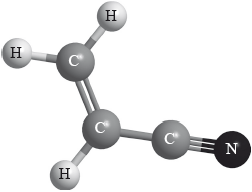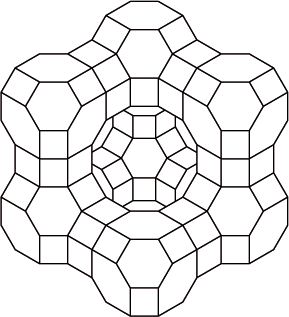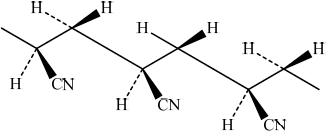| Date | November 2013 | Marks available | 2 | Reference code | 13N.3.sl.TZ0.9 |
| Level | SL | Paper | 3 | Time zone | TZ0 |
| Command term | Draw | Question number | 9 | Adapted from | N/A |
Question
Polyacrylonitrile is an important polymer used in the manufacture of carbon fibres. The monomer has the structure below.

The rate of the polymerization reaction from the gaseous monomer is increased in the presence of a zeolite with the cage structure shown.

A new range of light batteries has been developed that uses open carbon nanotubes, covered with silicon, as electrodes.
Polyacrylonitrile is similar to polypropene and can exist in two forms.
Draw the structure of the isotactic form of polyacrylonitrile showing three repeating units.
Polyacrylonitrile is similar to polypropene and can exist in two forms.
Explain why the isotactic form is more suitable for the manufacture of strong fibres.
Identify the role of the zeolite in the reaction.
Suggest an explanation for its efficiency in favouring the production of the crystalline polymer.
Outline the structure of the open carbon nanotubes.
State a property of these nanotubes that makes them suitable for this use.
Markscheme
 /
/
 ;
;
Continuation bonds at end of structure needed.
Hydrogen atoms must be included.
Award [1] for chain with CN groups on alternate carbons.
Award [2] for correct chain with CN on alternate carbons with same orientation.
chains pack together better;
strong intermolecular/attractive forces between chains;
chains do not move past each other easily (so fibre strong/rigid);
catalyst;
(selective) because of dimensions/shape/size (of cage);
Accept “large surface area”.
cylinder with hexagons of carbon (atoms);
Accept suitable diagram.
Do not award mark if pentagons are also mentioned.
(electrical) conductor;
Accept low density.
Do not accept light.
Examiners report
Some very strange polymers were suggested in (a) (i) with the –CN group becoming integrated into the carbon backbone. Candidates were, however, able to explain why the isotactic form is more suitable for fibres. The role of the zeolite in (b) was usually correctly identified but it was not known that the dimensions, size or shape of the cage were an explanation for its efficiency. Most were able to give a good account of carbon nanotubes although some introduced pentagons at the end. This was specifically ruled out in the question – open carbon nano-tubes.
Some very strange polymers were suggested in (a) (i) with the –CN group becoming integrated into the carbon backbone. Candidates were, however, able to explain why the isotactic form is more suitable for fibres. The role of the zeolite in (b) was usually correctly identified but it was not known that the dimensions, size or shape of the cage were an explanation for its efficiency. Most were able to give a good account of carbon nanotubes although some introduced pentagons at the end. This was specifically ruled out in the question – open carbon nano-tubes.
Some very strange polymers were suggested in (a) (i) with the –CN group becoming integrated into the carbon backbone. Candidates were, however, able to explain why the isotactic form is more suitable for fibres. The role of the zeolite in (b) was usually correctly identified but it was not known that the dimensions, size or shape of the cage were an explanation for its efficiency. Most were able to give a good account of carbon nanotubes although some introduced pentagons at the end. This was specifically ruled out in the question – open carbon nano-tubes.
Some very strange polymers were suggested in (a) (i) with the –CN group becoming integrated into the carbon backbone. Candidates were, however, able to explain why the isotactic form is more suitable for fibres. The role of the zeolite in (b) was usually correctly identified but it was not known that the dimensions, size or shape of the cage were an explanation for its efficiency. Most were able to give a good account of carbon nanotubes although some introduced pentagons at the end. This was specifically ruled out in the question – open carbon nano-tubes.
Some very strange polymers were suggested in (a) (i) with the –CN group becoming integrated into the carbon backbone. Candidates were, however, able to explain why the isotactic form is more suitable for fibres. The role of the zeolite in (b) was usually correctly identified but it was not known that the dimensions, size or shape of the cage were an explanation for its efficiency. Most were able to give a good account of carbon nanotubes although some introduced pentagons at the end. This was specifically ruled out in the question – open carbon nano-tubes.
Some very strange polymers were suggested in (a) (i) with the –CN group becoming integrated into the carbon backbone. Candidates were, however, able to explain why the isotactic form is more suitable for fibres. The role of the zeolite in (b) was usually correctly identified but it was not known that the dimensions, size or shape of the cage were an explanation for its efficiency. Most were able to give a good account of carbon nanotubes although some introduced pentagons at the end. This was specifically ruled out in the question – open carbon nano-tubes.

